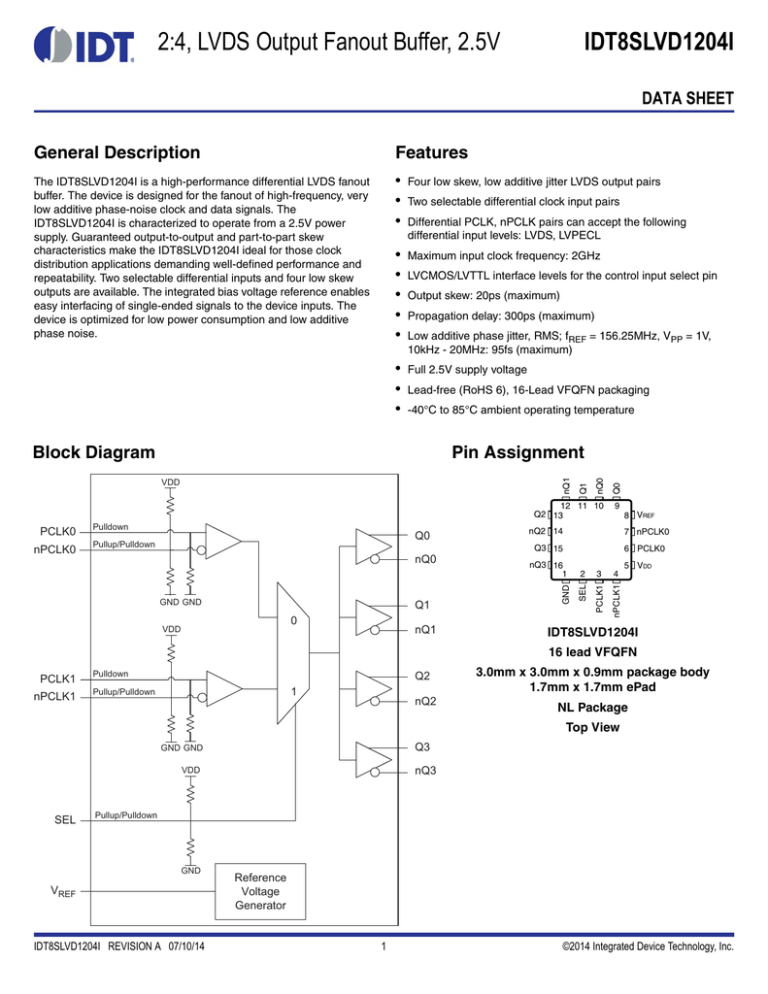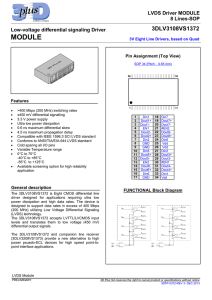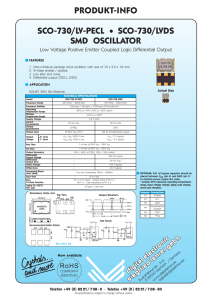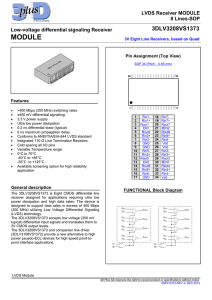
2:4, LVDS Output Fanout Buffer, 2.5V
IDT8SLVD1204I
DATA SHEET
General Description
Features
The IDT8SLVD1204I is a high-performance differential LVDS fanout
buffer. The device is designed for the fanout of high-frequency, very
low additive phase-noise clock and data signals. The
IDT8SLVD1204I is characterized to operate from a 2.5V power
supply. Guaranteed output-to-output and part-to-part skew
characteristics make the IDT8SLVD1204I ideal for those clock
distribution applications demanding well-defined performance and
repeatability. Two selectable differential inputs and four low skew
outputs are available. The integrated bias voltage reference enables
easy interfacing of single-ended signals to the device inputs. The
device is optimized for low power consumption and low additive
phase noise.
•
•
•
Four low skew, low additive jitter LVDS output pairs
•
•
•
•
•
Maximum input clock frequency: 2GHz
•
•
•
Full 2.5V supply voltage
Two selectable differential clock input pairs
Differential PCLK, nPCLK pairs can accept the following
differential input levels: LVDS, LVPECL
LVCMOS/LVTTL interface levels for the control input select pin
Output skew: 20ps (maximum)
Propagation delay: 300ps (maximum)
Low additive phase jitter, RMS; fREF = 156.25MHz, VPP = 1V,
10kHz - 20MHz: 95fs (maximum)
Lead-free (RoHS 6), 16-Lead VFQFN packaging
-40°C to 85°C ambient operating temperature
12 11 10
Q2 13
Q0
Pullup/Pulldown
9
8 VREF
nQ2 14
7 nPCLK0
Q3 15
Q1
0
VDD
nQ1
nQ3 16
1
5 VDD
2
3
4
PCLK1
GND GND
6 PCLK0
nPCLK1
nQ0
SEL
nPCLK0
Pulldown
GND
PCLK0
Q0
VDD
nQ0
nQ1
Pin Assignment
Q1
Block Diagram
IDT8SLVD1204I
16 lead VFQFN
PCLK1
nPCLK1
Pulldown
Q2
1
Pullup/Pulldown
nQ2
3.0mm x 3.0mm x 0.9mm package body
1.7mm x 1.7mm ePad
NL Package
Top View
Q3
GND GND
nQ3
VDD
SEL
Pullup/Pulldown
GND
VREF
IDT8SLVD1204I REVISION A 07/10/14
Reference
Voltage
Generator
1
©2014 Integrated Device Technology, Inc.
IDT8SLVD1204I DATA SHEET
Pin Description and Pin Characteristic Tables
Table 1. Pin Descriptions
Number
Name
Type
Description
1
GND
Power
2
SEL
Input
Pullup/
Pulldown
Reference select control pin. See Table 3 for function. LVCMOS/LVTTL
interface levels.
3
PCLK1
Input
Pulldown
Non-inverting differential clock/data input.
4
nPCLK1
Input
Pullup/
Pulldown
Inverting differential clock/data input. VDD/2 default when left floating.
5
VDD
Power
6
PCLK0
Input
Pulldown
Non-inverting differential clock/data input.
7
nPCLK0
Input
Pullup/
Pulldown
Inverting differential clock/data input. VDD/2 default when left floating.
8
VREF
Output
Bias voltage reference for the PCLK, nPCLK inputs.
9, 10
Q0, nQ0
Output
Differential output pair 0. LVDS interface levels.
11, 12
Q1, nQ1
Output
Differential output pair 1. LVDS interface levels.
13, 14
Q2, nQ2
Output
Differential output pair 2. LVDS interface levels.
15, 16
Q3, nQ3
Output
Differential output pair 3. LVDS interface levels.
Power supply ground.
Power supply pin.
NOTE: Pulldown and Pullup refer to internal input resistors. See Table 2, Pin Characteristics, for typical values.
Table 2. Pin Characteristics
Symbol
Parameter
Test Conditions
Minimum
Typical
Maximum
Units
CIN
Input Capacitance
2
pF
RPULLDOWN
Input Pulldown Resistor
51
k
RPULLUP
Input Pullup Resistor
51
k
Function Table
Table 3. SEL Input Selection Function Table
Input
SEL
Operation
0
PCLK0, nPCLK0 is the selected differential clock input.
1
PCLK1, nPCLK1 is the selected differential clock input.
Open (default)
Input buffers are disabled and outputs are static.
NOTE: SEL is an asynchronous control.
2:4, LVDS OUTPUT FANOUT BUFFER, 2.5V
2
REVISION A 07/10/14
IDT8SLVD1204I DATA SHEET
Absolute Maximum Ratings
NOTE: Stresses beyond those listed under Absolute Maximum Ratings may cause permanent damage to the device. These ratings are stress
specifications only. Functional operation of product at these conditions or any conditions beyond those listed in the DC Characteristics or AC
Characteristics is not implied. Exposure to absolute maximum rating conditions for extended periods may affect product reliability.
Item
Rating
Supply Voltage, VDD
4.6V
Inputs, VI
-0.5V to VDD + 0.5V
Outputs, IO
Continuous Current
Surge Current
10mA
15mA
VREF current Sink/Source, IREF
±2mA
Maximum Junction Temperature, TJ,MAX
125°C
Storage Temperature, TSTG
-65C to 150C
ESD - Human Body Model, NOTE 1
2000V
ESD - Charged Device Model, NOTE 1
1500V
NOTE 1: According to JEDEC/JESD JS-001-2012/22-C101E.
Electrical Characteristics
Table 4A. Power Supply Characteristics, VDD = 2.5V ± 5%, TA = -40°C to 85°C
Symbol
Parameter
VDD
Power Supply Voltage
IDD
Test Conditions
Power Supply Current
Minimum
Typical
Maximum
Units
2.375
2.5
2.625
V
SEL = 0 or 1; fREF = 100MHz;
Q0 to Q3 terminated 100 between nQx, Qx
84
100
mA
SEL = 0 or 1; fREF = 800MHz;
Q0 to Q3 terminated 100 between nQx, Qx
84
100
mA
SEL = 0 or 1; fREF = 2GHz;
Q0 to Q3 terminated 100 between nQx, Qx
84
100
mA
Typical
Maximum
Units
Table 4B. LVCMOS/LVTTL DC Characteristics, VDD = 2.5V ± 5%, TA = -40°C to 85°C
Symbol
Parameter
VdI3
Open-Pin Voltage
(Default State)
SEL
VIH
Input High Voltage
SEL
0.7 * VDD
VDD + 0.3
V
VIL
Input Low Voltage
SEL
-0.3
0.2 * VDD
V
IIH
Input High Current
SEL
VDD = VIN = 2.625V
150
µA
IIL
Input Low Current
SEL
VDD = 2.625V, VIN = 0V
REVISION A 07/10/14
Test Conditions
Minimum
VDD / 2
Open
3
-150
V
µA
2:4, LVDS OUTPUT FANOUT BUFFER, 2.5V
IDT8SLVD1204I DATA SHEET
Table 4C. Differential Input DC Characteristics, VDD = 2.5V ± 5%, TA = -40°C to 85°C
Symbol
Parameter
Test Conditions
IIH
Input High
Current
IIL
Input Low
Current
VREF
Reference Voltage for Input Bias
VPP
Peak-to-Peak Voltage; NOTE 1
VCMR
Common Mode Input Voltage;
NOTE 1, 2
Minimum
Typical
Maximum
Units
150
µA
PCLK0, nPCLK1
PCLK1, nPCLK1
VDD = VIN = 2.625V
PCLK0, PCLK1
VDD = 2.625V, VIN = 0V
-10
µA
nPCLK0,
nPCLK1
VDD = 2.625V, VIN = 0V
-150
µA
IREF = ±1mA
VDD – 1.50
fREF < 1.5 GHz
fREF > 1.5 GHz
VDD – 1.35
VDD – 1.15
V
0.1
1.5
V
0.2
1.5
V
1.0
VDD – 0.6
V
Maximum
Units
450
mV
50
mV
1.45
V
50
mV
NOTE 1: VIL should not be less than -0.3V.
NOTE 2: Common mode input voltage is defined at the crosspoint.
Table 4D. LVDS DC Characteristics, VDD = 2.5V ± 5%, TA = -40°C to 85°
Symbol
Parameter
VOD
Differential Output Voltage
VOD
VOD Magnitude Change
VOS
Offset Voltage
VOS
VOS Magnitude Change
2:4, LVDS OUTPUT FANOUT BUFFER, 2.5V
Test Conditions
Minimum
250
1.15
4
Typical
REVISION A 07/10/14
IDT8SLVD1204I DATA SHEET
AC Electrical Characteristics
Table 5. AC Electrical Characteristics, VDD = 2.5V ± 5%, TA = -40°C to 85°C
Symbol
Parameter
Test Conditions
fREF
Input
Frequency
PCLK[0:1],
nPCLK[0:1]
V/t
Input
Edge Rate
PCLK[0:1],
nPCLK[0:1]
tPD
Propagation Delay;
NOTE 1
tsk(o)
Minimum
Typical
Maximum
Units
2
GHz
1.5
PCLK[0:1], nPCLK[0:1] to any Qx, nQx
for VPP = 0.1V or 0.3V
300
ps
Output Skew; NOTE 2, 3
20
ps
tsk(i)
Input Skew; NOTE 3
20
ps
tsk(p)
Pulse Skew
15
ps
tsk(pp)
Part-to-Part Skew;
NOTE 3, 4
230
ps
tJIT
Buffer Additive Phase
Jitter, RMS; refer to
Additive Phase Jitter
Section
120
V/ns
210
fREF = 100MHz
fREF = 122.88MHz Square Wave, VPP = 1V,
Integration Range: 1kHz – 40MHz
138
205
fs
fREF = 122.88MHz Square Wave, VPP = 1V,
Integration Range: 10kHz – 20MHz
92
135
fs
fREF = 122.88MHz Square Wave, VPP = 1V,
Integration Range: 12kHz – 20MHz
92
135
fs
fREF = 156.25MHz Square Wave, VPP = 1V,
Integration Range: 1kHz – 40MHz
89
130
fs
fREF = 156.25MHz Square Wave, VPP = 1V,
Integration Range: 10kHz – 20MHz
65
95
fs
fREF = 156.25MHz Square Wave, VPP = 1V,
Integration Range: 12kHz – 20MHz
65
95
fs
fREF = 156.25MHz Square Wave, VPP = 0.5V,
Integration Range: 1kHz – 40MHz
87
130
fs
fREF = 156.25MHz Square Wave, VPP = 0.5V,
Integration Range: 10kHz – 20MHz
64
95
fs
fREF = 156.25MHz Square Wave, VPP = 0.5V,
Integration Range: 12kHz – 20MHz
64
95
fs
250
ps
tR / tF
Output Rise/ Fall Time
20% to 80%
outputs loaded with 100
MUXISOLATION
Mux Isolation; NOTE 5
fREF = 100MHz
40
72
dB
NOTE: Electrical parameters are guaranteed over the specified ambient operating temperature range, which is established when the device is
mounted in a test socket with maintained transverse airflow greater than 500 lfpm. The device will meet specifications after thermal equilibrium
has been reached under these conditions.
NOTE 1: Measured from the differential input crosspoint to the differential output crosspoint.
NOTE 2: Defined as skew between outputs at the same supply voltage and with equal load conditions. Measured at the differential crosspoint.
NOTE 3: This parameter is defined in accordance with JEDEC Standard 65.
NOTE 4: Defined as skew between outputs on different devices operating at the same supply voltage, same frequency, same temperature and
with equal load conditions. Using the same type of inputs on each device, the outputs are measured at the differential crosspoint.
NOTE 5: Qx, nQx outputs measured differentially. See MUX Isolation diagram in the Parameter Measurement Information section.
REVISION A 07/10/14
5
2:4, LVDS OUTPUT FANOUT BUFFER, 2.5V
IDT8SLVD1204I DATA SHEET
Additive Phase Jitter
The spectral purity in a band at a specific offset from the fundamental
compared to the power of the fundamental is called the dBc Phase
Noise. This value is normally expressed using a Phase noise plot
and is most often the specified plot in many applications. Phase noise
is defined as the ratio of the noise power present in a 1Hz band at a
specified offset from the fundamental frequency to the power value of
the fundamental. This ratio is expressed in decibels (dBm) or a ratio
of the power in the 1Hz band to the power in the fundamental. When
the required offset is specified, the phase noise is called a dBc value,
which simply means dBm at a specified offset from the fundamental.
By investigating jitter in the frequency domain, we get a better
understanding of its effects on the desired application over the entire
time record of the signal. It is mathematically possible to calculate an
expected bit error rate given a phase noise plot.
SSB Phase Noise (dBc/Hz)
Additive Phase Jitter @ 156.25MHz, VPP = 1V,
Integration Range (12kHz to 20MHz) = 65fs (typical)
Offset from Carrier Frequency (Hz)
As with most timing specifications, phase noise measurements have
issues relating to the limitations of the measurement equipment. The
noise floor of the equipment can be higher or lower than the noise
floor of the device. Additive phase noise is dependent on both the
noise floor of the input source and measurement equipment.
2:4, LVDS OUTPUT FANOUT BUFFER, 2.5V
Measured using a Wenzel 156.25MHz Oscillator as the input source.
6
REVISION A 07/10/14
IDT8SLVD1204I DATA SHEET
Parameter Measurement Information
VDD
VDD
nPCLK[0:1]
PCLK[0:1]
GND
LVDS Output Load Test Circuit
Differential Input Level
nPCLK[0:1]
nQx
PCLK[0:1]
Qx
nQy
nQy
Qy
t PLH
Qy
t PHL
tsk(p) = |t PHL - t PLH|
Pulse Skew
Output Skew
Par t 1
nQx
nQ[0:3]
80%
80%
Qx
nQy
VOD
Par t 2
Q[0:3]
20%
20%
tR
tF
Qy
tsk(pp)
Part-to-Part Skew
REVISION A 07/10/14
Output Rise/Fall Time
7
2:4, LVDS OUTPUT FANOUT BUFFER, 2.5V
IDT8SLVD1204I DATA SHEET
Parameter Measurement Information, continued
nPCLK0
Spectrum of Output Signal Q
PCLK0
MUX selects active
input clock signal
A0
Amplitude (dB)
nPCLK1
PCLK1
nQ[0:3]
MUX_ISOLATION = A0 – A1
MUX selects other input
A1
Q[0:3]
tPD2
tPD1
ƒ
(fundamental)
tsk(i)
Frequency
tsk(i) = |tPD1 - tPD2|
Input Skew
MUX Isolation
nPCLK[0:1]
PCLK[0:1]
nQ[0:3]
Q[0:3]
tPD
Propagation Delay
Offset Voltage Setup
Differential Output Voltage Setup
2:4, LVDS OUTPUT FANOUT BUFFER, 2.5V
8
REVISION A 07/10/14
IDT8SLVD1204I DATA SHEET
Applications Information
Recommendations for Unused Input and Output Pins
Inputs:
Outputs:
PCLK/nPCLK Inputs
LVDS Outputs
For applications not requiring the use of a differential input, both the
PCLK and nPCLK pins can be left floating. Though not required, but
for additional protection, a 1k resistor can be tied from PCLK to
ground.
All unused LVDS output pairs can be either left floating or terminated
with 100 across. If they are left floating, there should be no trace
attached.
Wiring the Differential Input to Accept Single-Ended Levels
Figure 1 shows how a differential input can be wired to accept single
ended levels. The reference voltage V1 = VDD/2 is generated by the
bias resistors R1 and R2. The bypass capacitor (C1) is used to help
filter noise on the DC bias. This bias circuit should be located as close
to the input pin as possible. The ratio of R1 and R2 might need to be
adjusted to position the V1 in the center of the input voltage swing.
For example, if the input clock swing is 2.5V and VDD = 2.5V, R1 and
R2 value should be adjusted to set V1 at 1.25V. The values below are
for when both the single ended swing and VDD are at the same
voltage. This configuration requires that the sum of the output
impedance of the driver (Ro) and the series resistance (Rs) equals
the transmission line impedance. In addition, matched termination at
the input will attenuate the signal in half. This can be done in one of
two ways. First, R3 and R4 in parallel should equal the transmission
line impedance. For most 50 applications, R3 and R4 can be 100.
The values of the resistors can be increased to reduce the loading for
slower and weaker LVCMOS driver. When using single-ended
signaling, the noise rejection benefits of differential signaling are
reduced. Even though the differential input can handle full rail
LVCMOS signaling, it is recommended that the amplitude be
reduced. The datasheet specifies a lower differential amplitude,
however this only applies to differential signals. For single-ended
applications, the swing can be larger, however VIL cannot be less
than -0.3V and VIH cannot be more than VDD + 0.3V. Though some
of the recommended components might not be used, the pads
should be placed in the layout. They can be utilized for debugging
purposes. The datasheet specifications are characterized and
guaranteed by using a differential signal.
Figure 1. Recommended Schematic for Wiring a Differential Input to Accept Single-ended Levels
REVISION A 07/10/14
9
2:4, LVDS OUTPUT FANOUT BUFFER, 2.5V
IDT8SLVD1204I DATA SHEET
2.5V LVPECL Clock Input Interface
The PCLK /nPCLK accepts LVPECL, LVDS, and other differential
signals. Both signals must meet the VPP and VCMR input
requirements. Figures 2A to 2C show interface examples for the
PCLK/ nPCLK input driven by the most common driver types. The
input interfaces suggested here are examples only. If the driver is
from another vendor, use their termination recommendation. Please
consult with the vendor of the driver component to confirm the driver
termination requirements.
2.5V
2.5V
2.5V
PCLK
nPCLK
LVPECL
Input
LVPECL
Figure 2B. PCLK/nPCLK Input Driven by a
2.5V LVPECL Driver with AC Couple
Figure 2A. PCLK/nPCLK Input Driven by a
2.5V LVPECL Driver
PCLK
nPCLK
Figure 2C. PCLK/nPCLK Input Driven by a
2.5V LVDS Driver
2:4, LVDS OUTPUT FANOUT BUFFER, 2.5V
10
REVISION A 07/10/14
IDT8SLVD1204I DATA SHEET
LVDS Driver Termination
For a general LVDS interface, the recommended value for the
termination impedance (ZT) is between 90 and 132. The actual
value should be selected to match the differential impedance (Z0) of
your transmission line. A typical point-to-point LVDS design uses a
100 parallel resistor at the receiver and a 100 differential
transmission-line environment. In order to avoid any
transmission-line reflection issues, the components should be
surface mounted and must be placed as close to the receiver as
possible. IDT offers a full line of LVDS compliant devices with two
types of output structures: current source and voltage source. The
LVDS
Driver
standard termination schematic as shown in Figure 3A can be used
with either type of output structure. Figure 3B, which can also be
used with both output types, is an optional termination with center tap
capacitance to help filter common mode noise. The capacitor value
should be approximately 50pF. If using a non-standard termination, it
is recommended to contact IDT and confirm if the output structure is
current source or voltage source type. In addition, since these
outputs are LVDS compatible, the input receiver’s amplitude and
common-mode input range should be verified for compatibility with
the output.
ZO ZT
ZT
LVDS
Receiver
Figure 3A. Standard Termination
LVDS
Driver
ZO ZT
C
ZT
2 LVDS
ZT Receiver
2
Figure 3B. Optional Termination
LVDS Termination
REVISION A 07/10/14
11
2:4, LVDS OUTPUT FANOUT BUFFER, 2.5V
IDT8SLVD1204I DATA SHEET
VFQFN EPAD Thermal Release Path
In order to maximize both the removal of heat from the package and
the electrical performance, a land pattern must be incorporated on
the Printed Circuit Board (PCB) within the footprint of the package
corresponding to the exposed metal pad or exposed heat slug on the
package, as shown in Figure 4. The solderable area on the PCB, as
defined by the solder mask, should be at least the same size/shape
as the exposed pad/slug area on the package to maximize the
thermal/electrical performance. Sufficient clearance should be
designed on the PCB between the outer edges of the land pattern
and the inner edges of pad pattern for the leads to avoid any shorts.
and dependent upon the package power dissipation as well as
electrical conductivity requirements. Thus, thermal and electrical
analysis and/or testing are recommended to determine the minimum
number needed. Maximum thermal and electrical performance is
achieved when an array of vias is incorporated in the land pattern. It
is recommended to use as many vias connected to ground as
possible. It is also recommended that the via diameter should be 12
to 13mils (0.30 to 0.33mm) with 1oz copper via barrel plating. This is
desirable to avoid any solder wicking inside the via during the
soldering process which may result in voids in solder between the
exposed pad/slug and the thermal land. Precautions should be taken
to eliminate any solder voids between the exposed heat slug and the
land pattern. Note: These recommendations are to be used as a
guideline only. For further information, please refer to the Application
Note on the Surface Mount Assembly of Amkor’s Thermally/
Electrically Enhance Leadframe Base Package, Amkor Technology.
While the land pattern on the PCB provides a means of heat transfer
and electrical grounding from the package to the board through a
solder joint, thermal vias are necessary to effectively conduct from
the surface of the PCB to the ground plane(s). The land pattern must
be connected to ground through these vias. The vias act as “heat
pipes”. The number of vias (i.e. “heat pipes”) are application specific
PIN
PIN PAD
SOLDER
EXPOSED HEAT SLUG
GROUND PLANE
THERMAL VIA
SOLDER
LAND PATTERN
(GROUND PAD)
PIN
PIN PAD
Figure 4. P.C. Assembly for Exposed Pad Thermal Release Path – Side View (drawing not to scale)
2:4, LVDS OUTPUT FANOUT BUFFER, 2.5V
12
REVISION A 07/10/14
IDT8SLVD1204I DATA SHEET
Power Considerations
This section provides information on power dissipation and junction temperature for the IDT8SLVD1204I. Equations and example calculations
are also provided.
1.
Power Dissipation.
The total power dissipation for the IDT8SLVD1204I is the sum of the core power plus the output power dissipation due to the load. The following
is the power dissipation for VDD = 2.5V + 5% = 2.625V, which gives worst case results.
•
2.
Total Power (core)MAX = VDD_MAX * IDD_MAX = 2.625V * 100mA = 262.5mW
Junction Temperature.
Junction temperature, Tj, is the temperature at the junction of the bond wire and bond pad directly affects the reliability of the device. The
maximum recommended junction temperature is 125°C. Limiting the internal transistor junction temperature, Tj, to 125°C ensures that the bond
wire and bond pad temperature remains below 125°C.
The equation for Tj is as follows: Tj = JA * Pd_total + TA
Tj = Junction Temperature
JA = Junction-to-Ambient Thermal Resistance
Pd_total = Total Device Power Dissipation (example calculation is in section 1 above)
TA = Ambient Temperature
In order to calculate junction temperature, the appropriate junction-to-ambient thermal resistance JA must be used. Assuming no air flow and
a multi-layer board, the appropriate value is 74.7°C/W per Table 6 below.
Therefore, Tj for an ambient temperature of 85°C with all outputs switching is:
85°C + 0.263W * 74.7°C/W = 104.6°C. This is below the limit of 125°C.
This calculation is only an example. Tj will obviously vary depending on the number of loaded outputs, supply voltage, air flow and the type of
board (multi-layer).
Table 6. Thermal Resistance JA for 16-Lead VFQFN, Forced Convection
JA at 0 Air Flow
Meters per Second
Multi-Layer PCB, JEDEC Standard Test Boards
REVISION A 07/10/14
0
1
2.5
74.7°C/W
65.3°C/W
58.5°C/W
13
2:4, LVDS OUTPUT FANOUT BUFFER, 2.5V
IDT8SLVD1204I DATA SHEET
Reliability Information
Table 7. JA vs. Air Flow Table for a 16-Lead VFQFN
JA at 0 Air Flow
Meters per Second
Multi-Layer PCB, JEDEC Standard Test Boards
0
1
2.5
74.7°C/W
65.3°C/W
58.5°C/W
Transistor Count
The transistor count for the IDT8SLVD1204I is: 417
2:4, LVDS OUTPUT FANOUT BUFFER, 2.5V
14
REVISION A 07/10/14
IDT8SLVD1204I DATA SHEET
16-Lead VFQFN Package Outline and Package Dimensions
REVISION A 07/10/14
15
2:4, LVDS OUTPUT FANOUT BUFFER, 2.5V
IDT8SLVD1204I DATA SHEET
Ordering Information
Table 8. Ordering Information
Part/Order Number
Marking
Package
Shipping Packaging
Temperature
8SLVD1204NLGI
1204I
“Lead-Free” 16-Lead VFQFN
Tube
-40C to 85C
8SLVD1204NLGI8
1204I
“Lead-Free” 16-Lead VFQFN
Tape & Reel,
pin 1 orientation: EIA-481-C
-40C to 85C
8SLVD1204NLGI/W
1204I
“Lead-Free” 16-Lead VFQFN
Tape & Reel,
pin 1 orientation: EIA-481-D
-40C to 85C
Table 9. Pin 1 Orientation in Tape and Reel Packaging
Part Number Suffix
Pin 1 Orientation
Illustration
Correct Pin 1 ORIENTATION
8
CARRIER TAPE TOPSIDE
(Round Sprocket Holes)
Quadrant 1 (EIA-481-C)
USER DIRECTION OF FEED
Correct Pin 1 ORIENTATION
/W
CARRIER TAPE TOPSIDE
(Round Sprocket Holes)
Quadrant 2 (EIA-481-D)
USER DIRECTION OF FEED
2:4, LVDS OUTPUT FANOUT BUFFER, 2.5V
16
REVISION A 07/10/14
IDT8SLVD1204I DATA SHEET
Revision History Sheet
Rev
Table
Page
A
T8
16
Ordering Info: Changed Tray to Tube.
2/26/2014
1
Corrected part number
7/8/2014
A
REVISION A 07/10/14
Description of Change
Date
17
2:4, LVDS OUTPUT FANOUT BUFFER, 2.5V
Corporate Headquarters
Sales
Tech Support
6024 Silver Creek Valley Road
San Jose, CA 95138 USA
1-800-345-7015 or 408-284-8200
Fax: 408-284-2775
www.IDT.com
email: clocks@idt.com
DISCLAIMER Integrated Device Technology, Inc. (IDT) and its subsidiaries reserve the right to modify the products and/or specifications described herein at any time and at IDT’s sole discretion. All information in
this document, including descriptions of product features and performance, is subject to change without notice. Performance specifications and the operating parameters of the described products are determined
in the independent state and are not guaranteed to perform the same way when installed in customer products. The information contained herein is provided without representation or warranty of any kind, whether
express or implied, including, but not limited to, the suitability of IDT’s products for any particular purpose, an implied warranty of merchantability, or non-infringement of the intellectual property rights of others. This
document is presented only as a guide and does not convey any license under intellectual property rights of IDT or any third parties.
IDT’s products are not intended for use in applications involving extreme environmental conditions or in life support systems or similar devices where the failure or malfunction of an IDT product can be reasonably
expected to significantly affect the health or safety of users. Anyone using an IDT product in such a manner does so at their own risk, absent an express, written agreement by IDT.
While the information presented herein has been checked for both accuracy and reliability, Integrated Device Technology (IDT) assumes no responsibility for either its use or for the infringement of any patents or
other rights of third parties, which would result from its use. No other circuits, patents, or licenses are implied. This product is intended for use in normal commercial applications. Any other applications, such as
those requiring extended temperature ranges, high reliability or other extraordinary environmental requirements are not recommended without additional processing by IDT. IDT reserves the right to change any
circuitry or specifications without notice. IDT does not authorize or warrant any IDT product for use in life support devices or critical medical instruments.
Integrated Device Technology, IDT and the IDT logo are registered trademarks of IDT. Product specification subject to change without notice. Other trademarks and service marks used herein, including protected
names, logos and designs, are the property of IDT or their respective third party owners.
Copyright ©2014 Integrated Device Technology, Inc.. All rights reserved.




